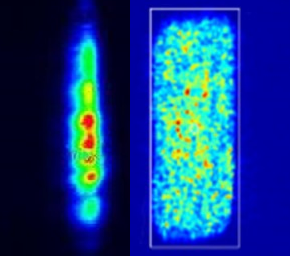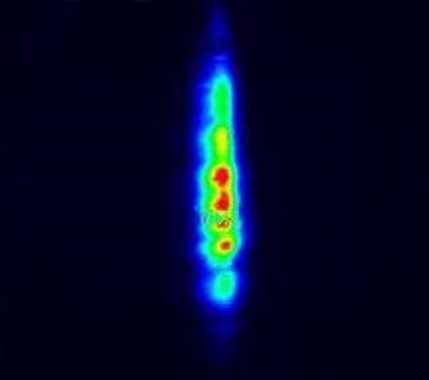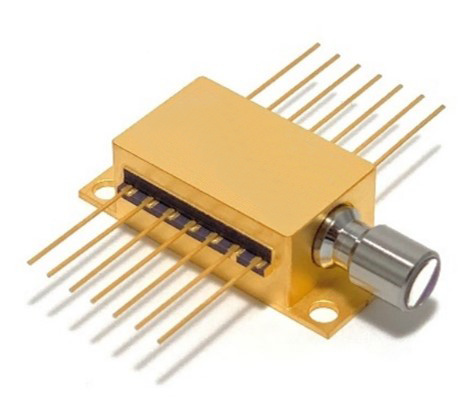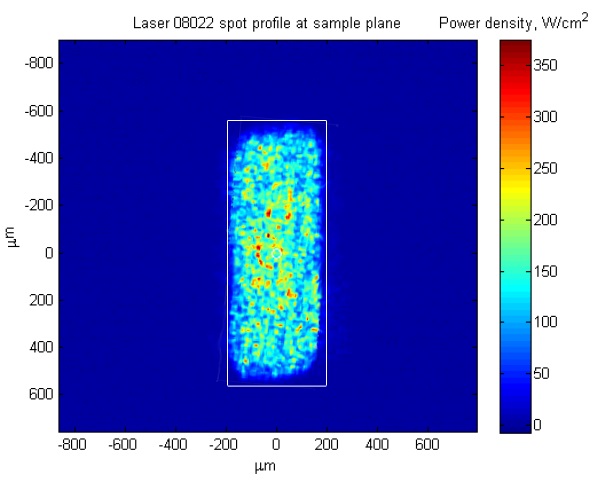
It is well known that the output beam characteristic of a multimode laser diode is inherently non-uniform, due to both spatial and temporal variations of the mode profile [Figure 1], that result from thermal lensing and filamentation [1]. These non-uniformities (‘hot-spots’ and ‘dark-spots’) can lead to deleterious effects for many applications, including solid-state laser pumping [2], Raman spectroscopy of sensitive materials [3], laser speckle contrast imaging [4], and laser illumination [5].

There have been many different methods utilized to homogenize the output power of a multimode laser beam. These methods include the use of mode-mixing in long lengths of multimode optical fibers or custom multi-faceted homogenizers [2,5], refractive beam shapers [6], and orbital rastering [3]. However, many of these beam tailoring techniques are often complicated, expensive, or require large amounts of real estate.
The “Stub laser,” shown below, incorporates a TEC-cooled, Volume Bragg Grating (VBG) spectrum-stabilized, multimode laser diode. This laser diode, housed in a compact 14-pin butterfly package, has a proprietary mode-mixing waveguide for beam homogenization [Figure 2].

Our proprietary multimode wavelength-stabilized laser features high output power (> 300 mW), narrow spectral bandwidth, and a shaped and homogenized beam profile [Figure 3]. The shaping and homogenization evenly spread out the power density and shapes the beam to match the field of view of a camera or spectrometer slit with minimal decrease in coherence length. Designed to meet the most demanding wavelength requirements and replace expensive DFB, DBR, fiber, and external cavity lasers, the multimode, spectrum stabilized laser offers superior wavelength stability over time and temperature (0.007 nm/°C), and vibration.

See our available Multimode, Homogenized, Open Beam, 14-Pin Laser Diodes here:
638nm 680nm 785nm 830nm 1064nm
This “stub laser” diode package configuration has shown improved performance for many of the applications listed above.
For Raman spectroscopy, the small footprint, high power, narrow laser linewidth, high signal to noise ratio, and output beam homogenization make this an ideal source for robust commercial systems.
For laser speckle contrast imaging [4], the narrow spectral linewidth, long coherence length, and output beam homogenization contributed to a 50% increase in global spectral contrast.
[1] A. Zeghuzi et al., IEEE Jl. Selected Topics in Quantum Electron., 25, 1502310 (2019).[2] S. Seyedzamani and E. Eslami, Optical Engineering, 56(8), 085106 (2017).
[3] J. Arno et al., Proc. SPIE 9101, 91010Q (2014).
[4] R. Chimenti, Laser Focus World, Nov 2020, 35 (2020).
[5] Y. Lutz and F. Christnacher, Proc SPIE 5087, 185 (2003).
[6] A. Laskin et al., Proc. SPIE 8600, 860010 (2013).
Talk to one of our knowledgeable Product Managers today by clicking the button below or emailing us at [email protected]!
Talk to a Product Manager

 SHIPS TODAY
SHIPS TODAY